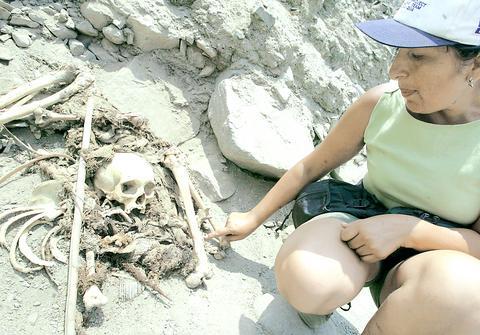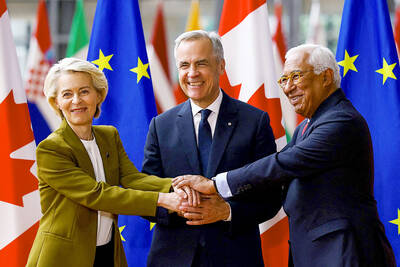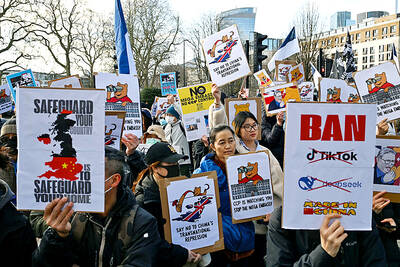Dozens of mummies dating back more than 500 years have been discovered on the path of a proposed highway on the outskirts of the Peruvian capital, near an Inca graveyard, archeologists said on Friday.
Archeologists uncovered 26 burial bundles, each containing one or more adult and child mummies dating from 1472 to 1532.

PHOTO: AP
In 1533, the Incas were defeated at the hands of the Spanish conquistadors.
"This [area] is part of the largest Inca cemetery in Peru and the largest excavated cemetery in the Western Hemisphere, that of Puruchuco-Huaquerones," said archeologist Guillermo Cock, who was contracted by Lima's town hall to comb the area for artifacts before construction could begin.
Cock said archeologists did not know the exact number of mummies at the site because they had not opened any of the bundles, which are still half-buried.
Some were already broken, exposing skulls and showing several hunched mummies with cloth bags tied to their bodies and offerings in their hands.
The mummies were once farmers and craftsmen and lived under the dominion of the Lati and Ishma Inca leaders, who ruled over the Rimac River valley, home to modern-day Lima, Cock said.
"These are local inhabitants, what we could now call middle class, belonging to the period of the Inca Empire, between 1472 and 1532," Cock told reporters.
He said they were textile makers: "Ninety-nine percent of the tools in the tombs are used for such production, from dressmaking to cloth dying. There are needles and looms.
"The important thing about this discovery is that it is intact. ... The area around the mummies shows evidence of rituals prior to the burials. There are the remains of corn, beans, coca leaves and pots," Cock said.
Despite the finding, the town hall said the road -- an extension to a busy urban highway - -- will go ahead.
"The works will not stop. They are an urban necessity. ... We will take the burial bales to a museum for conservation and for study. They could be plundered here," town hall spokesman Armando Molina said.
But archeologist Federico Kauffmann said Peru would be better off running the road through a tunnel under the site because it could yield further findings.
"In Peru, there is neither the money nor the techniques to preserve mummies, and there is no more space for mummies in the Puruchuco museum," he said.
Archeologists have uncovered thousands of mummies in Peru in recent years, mostly from the Inca culture five centuries ago, including about 2,000 unearthed from under a shantytown near the capital in 2002.
One of Peru's most famous mummies is "Juanita the Ice Maiden," a girl preserved in ice on a mountain. Last month, two mummies predating the Incas -- so well-preserved one had an eye intact -- were found under a school in southern Peru.

The team behind the long-awaited Vera Rubin Observatory in Chile yesterday published their first images, revealing breathtaking views of star-forming regions as well as distant galaxies. More than two decades in the making, the giant US-funded telescope sits perched at the summit of Cerro Pachon in central Chile, where dark skies and dry air provide ideal conditions for observing the cosmos. One of the debut images is a composite of 678 exposures taken over just seven hours, capturing the Trifid Nebula and the Lagoon Nebula — both several thousand light-years from Earth — glowing in vivid pinks against orange-red backdrops. The new image

Canada and the EU on Monday signed a defense and security pact as the transatlantic partners seek to better confront Russia, with worries over Washington’s reliability under US President Donald Trump. The deal was announced after a summit in Brussels between Canadian Prime Minister Mark Carney and European Commission President Ursula von der Leyen and European Council President Antonio Costa. “While NATO remains the cornerstone of our collective defense, this partnership will allow us to strengthen our preparedness ... to invest more and to invest smarter,” Costa told a news conference. “It opens new opportunities for companies on both sides of the

ESPIONAGE: The British government’s decision on the proposed embassy hinges on the security of underground data cables, a former diplomat has said A US intervention over China’s proposed new embassy in London has thrown a potential resolution “up in the air,” campaigners have said, amid concerns over the site’s proximity to a sensitive hub of critical communication cables. The furor over a new “super-embassy” on the edge of London’s financial district was reignited last week when the White House said it was “deeply concerned” over potential Chinese access to “the sensitive communications of one of our closest allies.” The Dutch parliament has also raised concerns about Beijing’s ideal location of Royal Mint Court, on the edge of the City of London, which has so

OVERHAUL: The move would likely mark the end to Voice of America, which was founded in 1942 to counter Nazi propaganda and operated in nearly 50 languages The parent agency of Voice of America (VOA) on Friday said it had issued termination notices to more than 639 more staff, completing an 85 percent decrease in personnel since March and effectively spelling the end of a broadcasting network founded to counter Nazi propaganda. US Agency for Global Media (USAGM) senior advisor Kari Lake said the staff reduction meant 1,400 positions had been eliminated as part of US President Donald Trump’s agenda to cut staffing at the agency to a statutory minimum. “Reduction in Force Termination Notices were sent to 639 employees at USAGM and Voice of America, part of a